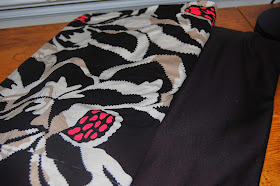Pattern Review is currently holding a four-week long sewing challenge aptly called "The Great Pattern Review Sewing Bee Contest." With mixed trepidation and excitement I signed up and this is the requirement for the week 1 challenge. Sew an A-Line skirt with the the following components: lining, waistband, zipper, some kind of closure, hemming. Sounds simple enough right? But with more than 300 participants, how do I create something that will stand out and give me a chance at advancing to the next round?
After rummaging through my modest pattern collection, I found this adorable "Tiffany Skirt" pattern from Serendipity Studio.
This is a multi-sized pattern (XXS-XXL) that offers six varying designs and two length options. By piecing fabrics of varying prints and colors, the possibilities are endless.
I decided to go with variation 2 which uses two fabrics. I fell in love with the dark plum and ivory combination of this two fabrics which I found in the quilting section of our local Jo-Ann's store.
100% cotton
The most basic of A-Line skirts would have one front piece and one back piece seamed together at the sides. In this pattern, the front and back were dissected into numerous interlocking pieces pretty much like a jigsaw puzzle. The addition of a scallop shape at the bottom edge of each interlocking piece serves to add a unique touch.
A total of 16 pieces made up the front and back skirt.
Note that in some of the pieces, I did not cut out the scallops at the bottom edge. I purposely left about 4 inches extra so I could hem the scallops instead of leaving them unfinished.
Looking at the number of pieces, making a muslin looked intimidating at first but there was an easy way to do it. Since I have never sewn a garment using this pattern company, I was not familiar with how the sizing went and I had to make a muslin. The skirt front and back were divided into top and bottom tiers and for the muslin, I only had to assemble the top tier pieces to determine if the waistline fit. I tried a size M based on my waistline measurement but the finished muslin was loose by 2" so I went down two sizes to get the right fit.
Now for the assembly:
Starting with the front skirt pieces, the top tier piece was joined to the corresponding bottom tier piece by overlapping 1" at the scalloped edge. This was repeated until all the top and bottom pieces were sewn together.
Since the design was supposed to feature frayed edges, the instructions called for straight machine stitching along the overlapped edges. I did not like the idea of fraying on my skirt so I went with zigzag stitches hoping they will control the fraying.
Once all the top and bottom pieces were sewn, the front panels were then seamed vertically.
Before doing the same with the back panels, the zipper had to be attached first. I preferred using an invisible zipper and just followed the instructions that came with the zipper packaging.
Once the front and back panels were assembled, they were then seamed together at the side.
However, after trying it on, I was not happy with the fit and I had to take in a few inches along the hip area while still trying to preserve the A silhouette.
Once I was happy with the fit, I drafted my own lining based on the finished skirt.
The lining pieces consisted of one front piece and two back pieces. The latter were sewn together along center back leaving an opening a little longer than the actual zipper opening--just enough so the lining did not get caught in the zipper.
The lining was joined to the skirt, wrong sides together.
Since I was planning on attaching a waistband (which was not included in the pattern), I skipped the facing. I just basted the two layers along the waistline and proceeded to prepare the waistband.
To create a waistband, I cut a 3" wide piece of contrast fabric the length of my waistline plus an extra 1-5/8" for the overlap at the back where I intended to sew the button.
I used a medium weight fusible interfacing on the waistband then folded 1/2" along one long side.
Using a clapper allowed for a very crisp folded edge in spite of the interfacing.
The unfolded edge of the waistband was attached to the waistline leaving approximately 1" overhang on the right side and around 5/8" on the left.
With the seam folded towards the waistband, I topstitched on the right side.
The next pictures illustrate how I sealed the short edges of the waistband so that the right side was flush with the zipper edge and the left side had an overhang for sewing buttonhole.
 |
Waistband folded towards the right side and sewn.
|
 |
Left opening edge of waistband.
Right opening edge of waistband
I used handstitching to secure the folded edge to the wrong side of the garment.
|
The pattern did not provide for hemming instructions as the scalloped bottom edge was supposed to be left unfinished to achieve a frayed look. However in keeping with the requirements of the challenge, I needed to hem the bottom of the skirt. Besides as mentioned previously I did not care for the frayed look.
The following pictures show how I achieved the finished scallop look.
 |
Folded extra hem allowance to the right side.
Serged the long edge.
Traced the scallops.
Stitched along the traced edge.
Trimmed closely around curves and clipped corners.
Turned scallops out.
Used lace hem tape to finish hemming.
For the lining, used narrow hem.
|
Finally, I added a crochet lace trim around the scalloped edges on the top to cover the zigzag stitches.
And here's my not so simple A-line skirt!





















.jpg)










































